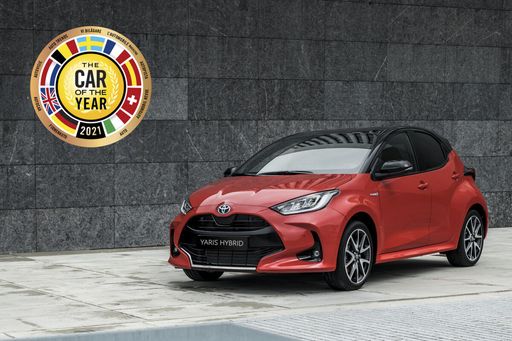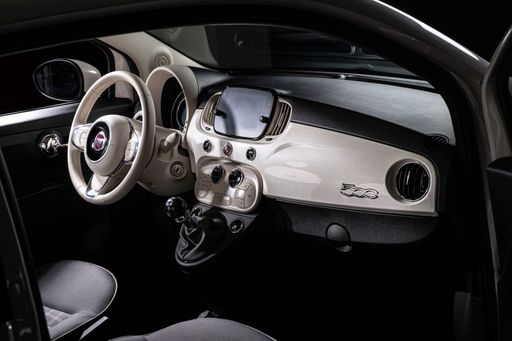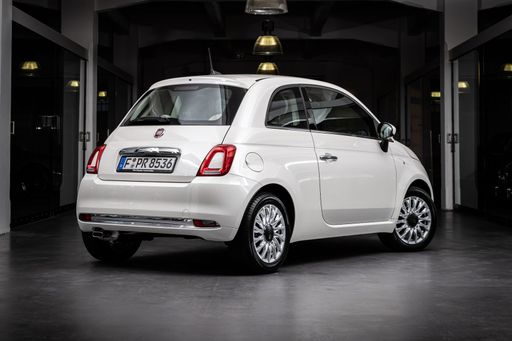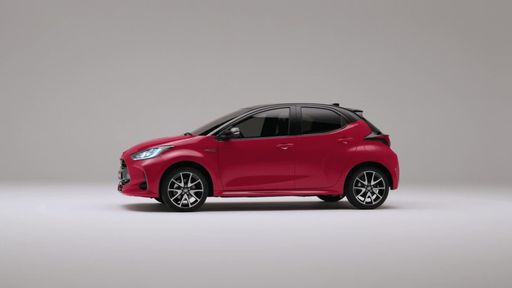The automotive market has seen a growing interest in compact hatchbacks, and two of the standout contenders are the Fiat 500 and Toyota Yaris. These vehicles embody different philosophies in design, performance, and technology, appealing to distinct types of consumers. This comparison delves into their technical aspects and innovations, showcasing how they stack up against each other.
Fiat 500 vs Toyota Yaris – Which one offers the better deal?
Everyday use, family trips or long-distance drives – here’s where the differences show.
Discover whether Fiat 500 or Toyota Yaris fits your lifestyle better.
Design and Dimensions
The Fiat 500 is a stylish hatchback that emphasizes compactness and urban maneuverability. With a length of 3,632 mm, width of 1,683 mm, and height of 1,527 mm, it is built for city driving. The design features rounded lines and a retro look, contributing to its charm.
On the other hand, the Toyota Yaris boasts a larger footprint with dimensions of 3,940 mm in length, 1,745 mm in width, and a height of 1,500 mm. Its more assertive design language includes sharper lines and a sporty stance, making it stand out in a crowd.
Powertrain Options and Performance
In terms of powertrains, the Fiat 500 is available as a fully electric vehicle, featuring a 37.3 kWh battery that delivers a maximum power of 118 HP (87 kW) and a remarkable torque of 220 Nm. The electric model boasts an impressive consumption rate of around 13-14.7 kWh/100 km, providing a cozy electric range that reaches up to 312 km. It provides smooth acceleration, going from 0-100 km/h in just 9 seconds, with a top speed of 150 km/h.
Conversely, the Toyota Yaris offers a range of options, including full hybrid and petrol engines. The hybrid variant can generate up to 116 HP (85 kW) and provides a superb fuel efficiency of about 3.8-4.2 L/100 km. It delivers slightly higher performance with a 0-100 km/h acceleration time of 9.2 seconds and a top speed of approximately 175 km/h. For a sportier experience, there’s an option that can push up to 130 HP and 230 km/h.
Interior and Comfort
Inside, the Fiat 500 is designed for comfort and style, accommodating four passengers with its chic layout. However, trunk capacity is limited to 185 liters, which may not suffice for extensive cargo needs. The interior features modern tech integrations, but some may find the space a bit snug.
In contrast, the Toyota Yaris provides seating for five passengers, enhancing its utility for families or group travels. The trunk capacity is considerably larger at 286 liters, making it a more versatile option for those requiring additional storage. Yaris’s cabin integrates Toyota's latest infotainment system, ensuring drivers and passengers stay connected and entertained.
Technological Innovations
When it comes to technological advancements, the Fiat 500 showcases features that align with modern demands for sustainability. Its electric drivetrain not only emphasizes low energy consumption but also adheres to CO2 efficiency class A, ensuring minimal environmental impact.
The Toyota Yaris excels with its hybrid technology, delivering excellent fuel efficiency and reducing emissions to a competitive 87-95 g/km. Furthermore, Toyota incorporates safety features and advanced driver-assistance systems, significantly enhancing the overall driving experience.
Conclusion
Choosing between the Fiat 500 and the Toyota Yaris ultimately depends on individual preferences and requirements. The Fiat 500 is ideal for those seeking a stylish, electric option perfect for city driving, whereas the Toyota Yaris offers more versatility, space, and hybrid technology for users who prioritize practicality without compromising on performance. Each vehicle brings unique strengths to the table, making this comparison an interesting exploration of the modern hatchback segment.
Here’s where it gets real: The technical differences in detail
Costs and Efficiency:
Looking at overall running costs, both models reveal some interesting differences in everyday economy.
Fiat 500 has a a bit advantage in terms of price – it starts at 18800 £, while the Toyota Yaris costs 21900 £. That’s a price difference of around 3009 £.
Fuel consumption also shows a difference: Toyota Yaris manages with 3.80 L and is therefore clearly perceptible more efficient than the Fiat 500 with 5.30 L. The difference is about 1.50 L per 100 km.
Engine and Performance:
Power, torque and acceleration are the classic benchmarks for car enthusiasts – and here, some clear differences start to show.
When it comes to engine power, the Toyota Yaris has a convincingly edge – offering 280 HP compared to 118 HP. That’s roughly 162 HP more horsepower.
In acceleration from 0 to 100 km/h, the Toyota Yaris is clearly quicker – completing the sprint in 5.50 s, while the Fiat 500 takes 9 s. That’s about 3.50 s faster.
In terms of top speed, the Toyota Yaris performs noticeable better – reaching 230 km/h, while the Fiat 500 tops out at 155 km/h. The difference is around 75 km/h.
There’s also a difference in torque: Toyota Yaris pulls decisively stronger with 390 Nm compared to 220 Nm. That’s about 170 Nm difference.
Space and Everyday Use:
Cabin size, boot volume and payload all play a role in everyday practicality. Here, comfort and flexibility make the difference.
Seats: Toyota Yaris offers to a small extent more seating capacity – 5 vs 4.
In curb weight, Toyota Yaris is minimal lighter – 1090 kg compared to 1141 kg. The difference is around 51 kg.
In terms of boot space, the Toyota Yaris offers evident more room – 286 L compared to 185 L. That’s a difference of about 101 L.
In maximum load capacity, the Toyota Yaris performs clearly better – up to 935 L, which is about 385 L more than the Fiat 500.
When it comes to payload, Toyota Yaris clearly perceptible takes the win – 525 kg compared to 325 kg. That’s a difference of about 200 kg.
Who wins the race?
The Toyota Yaris proves to be dominates this comparison and therefore becomes our DriveDuel Champion!
Toyota Yaris is the better all-rounder in this comparison.
 @ Toyota Motor Corporation
@ Toyota Motor Corporation
Toyota Yaris
Fiat 500
The Fiat 500 is a cheeky, retro‑styled city car that turns heads with its iconic looks and playful personality. Perfect for weaving through tight streets and easing into tiny parking spots, it’s aimed at buyers who want style and character more than grand touring prowess.
details @ Fiat / Stellantis Media
@ Fiat / Stellantis Media
 @ Fiat / Stellantis Media
@ Fiat / Stellantis Media
 @ Fiat / Stellantis Media
@ Fiat / Stellantis Media
Toyota Yaris
The Toyota Yaris is a sprightly city hatch that packs clever packaging, surprising comfort and fuel-sipping manners into a neat, easy-to-park package. It rewards sensible buyers with low running costs, friendly ergonomics and a forgiving drive, delivered with Japanese reliability and just enough personality to make errands feel a little less ordinary.
details @ Toyota Motor Corporation
@ Toyota Motor Corporation
 @ Toyota Motor Corporation
@ Toyota Motor Corporation
 @ Fiat / Stellantis Media
@ Fiat / Stellantis Media
|
 @ Toyota Motor Corporation
@ Toyota Motor Corporation
|
|
|
|
Costs and Consumption |
|
|---|---|
|
Price
18800 - 30800 £
|
Price
21900 - 46700 £
|
|
Consumption L/100km
5.30 L
|
Consumption L/100km
3.8 - 9.5 L
|
|
Consumption kWh/100km
13 - 14.7 kWh
|
Consumption kWh/100km
-
|
|
Electric Range
190 - 331 km
|
Electric Range
-
|
|
Battery Capacity
21.3 - 37.3 kWh
|
Battery Capacity
-
|
|
co2
0 - 120 g/km
|
co2
87 - 215 g/km
|
|
Fuel tank capacity
-
|
Fuel tank capacity
36 - 50 L
|
Dimensions and Body |
|
|---|---|
|
Body Type
Hatchback
|
Body Type
Hatchback
|
|
Seats
4
|
Seats
4 - 5
|
|
Doors
3 - 4
|
Doors
3 - 5
|
|
Curb weight
1141 - 1475 kg
|
Curb weight
1090 - 1356 kg
|
|
Trunk capacity
183 - 185 L
|
Trunk capacity
141 - 286 L
|
|
Length
3631 - 3632 mm
|
Length
3940 - 3995 mm
|
|
Width
1683 - 1684 mm
|
Width
1745 - 1805 mm
|
|
Height
1527 - 1532 mm
|
Height
1455 - 1500 mm
|
|
Max trunk capacity
440 - 550 L
|
Max trunk capacity
935 L
|
|
Payload
250 - 325 kg
|
Payload
289 - 525 kg
|
Engine and Performance |
|
|---|---|
|
Engine Type
Electric, Petrol MHEV
|
Engine Type
Full Hybrid, Petrol
|
|
Transmission
Automatic, Manuel
|
Transmission
Automatic, Manuel
|
|
Transmission Detail
Reduction Gearbox, Manual Gearbox
|
Transmission Detail
CVT, Manual Gearbox, Automatic Gearbox
|
|
Drive Type
Front-Wheel Drive
|
Drive Type
Front-Wheel Drive, All-Wheel Drive
|
|
Power HP
65 - 118 HP
|
Power HP
116 - 280 HP
|
|
Acceleration 0-100km/h
9 - 16.2 s
|
Acceleration 0-100km/h
5.5 - 9.7 s
|
|
Max Speed
135 - 155 km/h
|
Max Speed
175 - 230 km/h
|
|
Torque
220 Nm
|
Torque
390 Nm
|
|
Number of Cylinders
3
|
Number of Cylinders
3
|
|
Power kW
48 - 87 kW
|
Power kW
85 - 206 kW
|
|
Engine capacity
999 cm3
|
Engine capacity
1490 - 1618 cm3
|
General |
|
|---|---|
|
Model Year
2023 - 2025
|
Model Year
2024 - 2025
|
|
CO2 Efficiency Class
A, D
|
CO2 Efficiency Class
B, G
|
|
Brand
Fiat
|
Brand
Toyota
|
What drivetrain options does the Fiat 500 have?
The Fiat 500 is offered with Front-Wheel Drive.
The prices and data displayed are estimates based on German list prices and may vary by country. This information is not legally binding.
